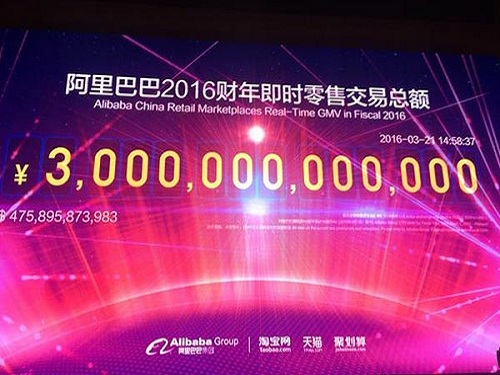
Alibaba China's retail trading volume (GMV) exceeded RMB 3 trillion. This means that Alibaba fully surpassed Wal-Mart in the fiscal year (April 1, 2015-March 31, 2016), becoming the world's largest retail platform. According to the data, Ali GMV was 2.95 trillion yuan in 2015, which accounted for 76.1% of the national online retail sales of 3,877.3 billion yuan, an increase of 29.8% over 2014's GMV. According to Ali’s current transaction volume and growth rate, Ali will not only achieve the goal of GMV breakthrough of RMB 3 trillion in this financial year, but will also enter the “three trillion†era in 2016. It is worth noting that the total retail sales of consumer goods in China in 2015 was approximately 30 trillion yuan. If the transaction volume of Ali continues to grow at a rapid rate, its GMV is likely to reach 10% of total retail sales of consumer goods in 2016, which means that Ali's core business ecosystem has begun to take shape.
In fact, Ali is not satisfied with the sustained and rapid growth of GMV. Ali believes that GMV's reach of RMB 3 trillion means that the company must undertake more social responsibilities and will build a healthier and more dynamic business ecosystem while helping its development. A number of people and businesses will achieve development and will integrate Ali's ecological resources. On the basis of continuing to promote the development of online and offline retail and service industries, they will feed back the manufacturing industry, promote employment and create tax revenue, and help the development of the real economy in the future.
"Three trillion" ecological era is coming
In 2015, the Ali GMV was 2.95 trillion yuan, which was only one step away from the 3 trillion yuan mark. However, Alibaba GMV still maintained a rapid growth in 2015, which is 29.8% higher than 2014's GMV. Under this growth rate, Alibaba entered the “three trillion†era in the company’s fiscal year 2016 and will not be a problem. Once this goal is achieved, Ali is expected to surpass Wal-Mart, the retail giant, in the fiscal year and leapfrog to become the world's largest retail platform.
On February 18th, Wal-Mart’s performance report showed that the annual operating income for the fiscal year ended January 31 (different from the start date of Alibaba's fiscal year) fell by 0.7% to US$482.1 billion (approximately RMB 314,244.44 million). Data analysis company According to S&P Capital IQ data, this is the company's first annual sales decline since 1980 and has been called “the worst performance in 35 years†by the outside world.
The growth rate of Wal-Mart stagnated, and Alibaba made great strides. In the fourth quarter of 2015, Ali GMV reached 964 billion yuan, a year-on-year increase of 22.5%. In the same period, the total retail sales of consumer goods in the country was 8.49 trillion yuan. Ali's trading volume accounts for 11.36% of the total retail sales in the country.
Ali's board of directors** Ma Yun used to describe the difference between Ali and Wal-Mart in 2015: “Walmart’s sales reached 3 trillion *** and it took more than 2 million, while we completed 3 trillion in the Amoy department. It is a completely new technology and a new idea that completely mobilizes the resources of the entire society and is a concept that allows society to participate together and become prosperous. Wal-Mart buys itself and sells itself to buy. We want more people to participate in. We don't recruit a lot of employees ourselves, but we create tremendous employment in society."
Ali believes that Ali can quickly overtake Wal-Mart because of a completely different business development model than Wal-Mart. The rise of Wal-Mart is inextricably linked with IT technology. Wal-Mart was one of the earliest retailers to use computers to track inventory (1969), was the first to use barcodes (1980), use EDI to better coordinate with suppliers (1985), launch their own communication satellites (1986 ) and one of the retail companies using wireless scanners (the late 1980s). IT technology has played a crucial role for Wal-Mart to increase efficiency and reduce costs.
Taobao, born in 2003, grew up in the era of DT (data technology), and its supporting technology and business service modules that are growing rapidly are big data technology, cloud computing, internet payment systems, internet credit systems, and smart logistics systems. Wal-Mart has achieved RMB 3 trillion, relying on approximately 2.2 million employees worldwide and approximately 11,000 stores under more than 70 brands in 28 countries and regions. Ali’s three trillion yuan depends on the continuous improvement and prosperity of the new business ecosystem.
The most representative of Ali's ecological prosperity was the scene when Ali New York was listed: When it was listed on the New York Stock Exchange, Alibaba chose the world's most unique way of ringing and vividly displayed its ecological composition to the world. A total of eight bell-clockers, including the two online shop owners, couriers, user representatives, an e-commerce service provider, Amoy girl and cloud customer service, there is a farmer from the United States, Pete-Wilfridge. The outsiders believe that the bell-clocker is a good example of the integrity and richness of Ali's ecology. In this business ecosystem, participants, service providers, and builders from the global retail industry are included. The business ecosystem is providing services to individuals and companies from all over the world and is able to continue to grow, merging more industry forms and services into this ecosystem.
Textile Conductive Filament,Conductive Yarn Knitting, Conductive Yarns Textiles, Conductive Textile Yarn
JIANGSU ZJA NEW MATERIAL CO., LTD , https://www.zjafiber.com